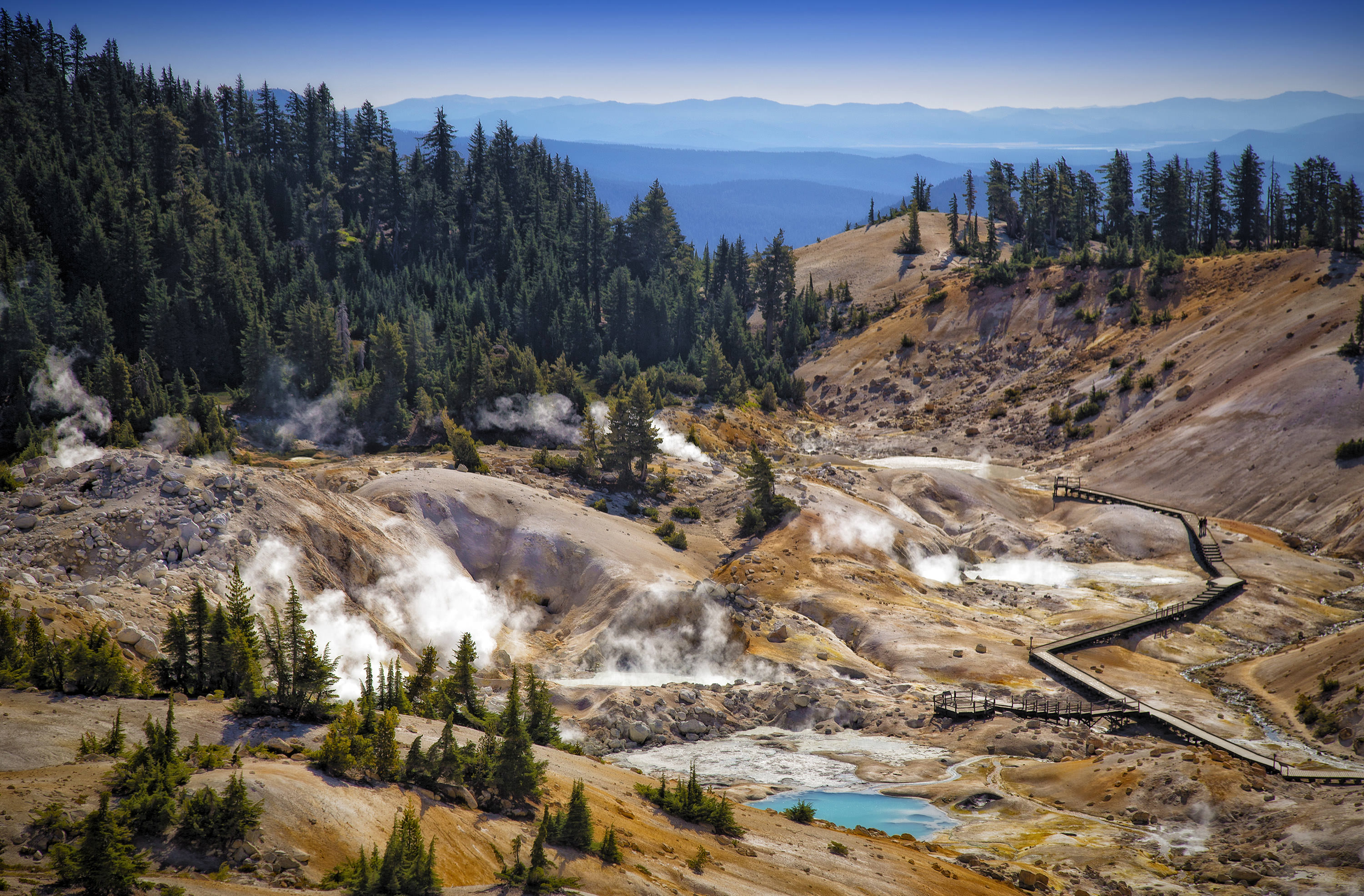Lassen Peak, the world’s largest plug-dome volcano, rises 2000ft over the surrounding landscape to 10,457ft above sea level. Classified as an active volcano, it erupted famously in 1915, spewing a giant cloud of smoke, steam and ash into the atmosphere. The national park was created the following year to protect the newly formed landscape.
The dry, smoldering, treeless terrain within Lassen's 106,000-acres stands in stunning contrast to the cool, green conifer forest that surrounds it. That’s in summer; in winter tons of snow ensures you won’t get too far inside its borders without some serious gear. Still, entering the park from the southwest entrance is to suddenly step into another world. The lavascape offers a fascinating glimpse into the earth’s fiery core. In a fuming display the terrain is marked by roiling hot springs, steamy mud pots, noxious sulfur vents, fumaroles, lava flows, cinder cones, craters and crater lakes.
In earlier times the region was a summer encampment and meeting point for the Atsugewi, Yana, Yahi and Maidu Native American tribes. They hunted deer and gathered plants for basketmaking here. Some Indigenous people still live nearby and work closely with the park to help educate visitors on their ancient history and contemporary culture.
Hiking in Lassen Volcanic National Park
Some areas destroyed by the blast, including the aptly named Devastated Area northeast of the peak, are recovering impressively. Hwy 89, the road through the park, wraps around Lassen Peak on three sides and provides access to dramatic geothermal formations, pure lakes, gorgeous picnic areas and remote hiking trails.
In total, the park has 150 miles of hiking trails, including a 17-mile section of the Pacific Crest Trail. Experienced hikers can attack the Lassen Peak Trail; it takes at least 4½ hours to make the 5-mile round-trip but the first 1.3 miles up to the Grandview viewpoint is suitable for families. The 360-degree view from the top is stunning, even if the weather is a bit hazy. Early in the season you’ll need snow and ice-climbing equipment to reach the summit.
Near the Kom Yah-mah-nee visitor facility, a gentler 2.3-mile trail, leads through meadows and forest to Mill Creek Falls. Further north on Hwy 89 you’ll recognize the roadside sulfur works by its bubbling mud pots, hissing steam vent, fountains and fumaroles. At Bumpass Hell a moderate 1.5-mile trail and boardwalk leads to an active geothermal area, with bizarrely colored pools and billowing clouds of steam.
The road and trails wind through cinder cones, lava and lush alpine glades, with views of Juniper Lake, Snag Lake and the plains beyond. Most of the lakes at higher elevations remain partially and beautifully frozen in summer. Leave time to fish, swim or boat on Manzanita Lake, a slightly lower emerald gem near the northern entrance.
Visiting Lassen Volcanic National Park
The park has two entrances. The northern entrance, at Manzanita Lake, is 50 miles east of Redding via Hwy 44. The southwest entrance is on Hwy 89, about 5 miles north of the junction with Hwy 36. From this junction it is 5 miles west on Hwy 36 to Mineral and 44 miles west to Red Bluff. Heading east on Hwy 36, Chester is 25 miles away and Susanville about 60 miles. Quincy is 65 miles southeast from the junction on Hwy 89.
Whether you enter at the north or southwest entrance, you’ll be given a free map with general information. About half a mile north of the park’s southwest entrance, the handsome Kom Yah-mah-nee Visitor Facility center is certified at the highest standard by the US Green Building Council. Inside there are educational exhibits (including a cool topographical volcano), a bookstore, an auditorium, a gift shop and a restaurant. Visitor information and maps available.
Just past the entrance-fee station at the park’s northern boundary, you can see exhibits and an orientation video inside the Manzanita Lake Visitors Center & Loomis Museum. During summer, rangers and volunteers lead programs on geology, wildlife, astronomy and local culture.
There’s virtually no way to visit this park without a car, though all the two-lane roads around the park and the ample free national-forest camping options make for excellent, if fairly serious, cycle touring.
Rangers tell rueful stories about people who drive across the country in their RVs to find the roads of Lassen Volcanic National Park impassable; don’t let it happen to you. The road through the park is usually only open from June to October, though it has been closed due to snow (as much as 40ft of it) well into July at times.
Travelers need to call ahead or check the park website to get weather conditions before considering a visit during all but a couple of months of the year – the only safe bets are August and September. A slow melt or freak storm can close major parts of the park at any other time of year.





